5 Little-Known Dumbbell Exercises For Seniors: Strengthen and Stay Pain-Free Post-50
As we age, staying physically active becomes increasingly important for maintaining overall health and well-being. Dumbbell exercises for seniors can help improve muscle strength, balance, flexibility, and bone density, leading to a more independent and fulfilling lifestyle.
As seniors, it’s crucial to engage in exercises that are safe, effective, and tailored to your specific needs. With dumbbells, you have the perfect equipment to target various muscle groups, from the upper body to the lower body and even the core.
Dumbbells are versatile and accessible tools that provide an excellent means of building strength, even from the comfort of your own home. You must have a source of progressive resistance for your exercise routine to build muscle and strength – bodyweight exercises alone won’t do it.
By consistently performing a well-designed home workout program incorporating dumbbell exercises into your routine, you’ll be able to better manage the physical challenges that come with aging and enjoy a higher quality of life.
In this post, we will discuss five little-known exercises that cater specifically to the needs of those over 50. We’ll also go over why strength training is critically important for seniors, and go over some frequently asked questions about strength training for seniors.
Related content on dumbbell exercises for seniors:
- Subscriber Q and A Video: 5 Great Free Weight Exercises For Over 50
- 5 Popular Exercises People Over 50 Should Never Do
- 10 Home Gym Essentials On A Budget For Full Body Workouts To Get You Strong Really Fast
Getting Started with Dumbbell Exercises for Seniors
As a senior looking to maintain a healthy and active lifestyle, incorporating dumbbell exercises into your fitness routine can be highly beneficial. Before you start, it’s essential to approach your workouts with safety in mind and seek guidance to ensure a safe and effective experience. Let’s explore some key steps to get you started with dumbbell exercises for seniors.
Consult Your Healthcare Professional
Before beginning any new exercise program, including dumbbell workouts, it’s wise to consult with your healthcare professional. They can assess your individual medical history and provide personalized recommendations. Your doctor will ensure that dumbbell exercises are safe and suitable for your specific health conditions or any existing concerns.
Choose the Right Dumbbell Weight
For seniors, it’s essential to choose a suitable weight to start, and gradually progress to heavier weights as you gain strength and confidence. Selecting the right dumbbell weight is critical to avoid injuries while getting the results you want.
Initially, this will take some experimentation on your part. Your goal is to find a weight that allows you to perform at least the minimum number in the rep range, but not more than the maximum number.
Take a guess, erring on the side of caution and choosing a weight you think will be kind of light. Start performing reps with proper form, aiming for the suggested rep range (9-12 for legs and midsection, 7-10 for upper body).
If you can’t get to the minimum number of the rep range, the weight is too heavy. If you reach the upper level of the rep range easily, the weight is a little light. And if you are forced to stop due to muscular fatigue somewhere between the minimum number and the upper level number of the given rep range, the weight is just right.
Focus on Proper Form and Posture
Maintaining proper form and posture during dumbbell exercises is essential for preventing injuries and maximizing the benefits of each movement. When using dumbbells, concentrate on your alignment and engage your abdominal muscles to support your spine. Avoid any jerky or sudden movements, and always perform the exercises in a controlled manner. Lift the dumbbells in about 2 seconds, lower in about 4 seconds.
Include a Warm-Up
Warm-up exercises are essential to prepare your body for the workout ahead and reduce the risk of injury. Gentle cardio movements, such as a stationary bike or marching in place, can help increase blood flow and warm up your muscles. After your dumbbell workout, perform gentle stretches to improve flexibility and aid in recovery.
Listen to Your Body
As a senior, it’s essential to listen to your body and not ignore what it’s telling you.
If you experience pain or discomfort during an exercise, stop immediately and consult your healthcare professional. Modify the exercises to suit your abilities and gradually challenge yourself as your strength and confidence improve.
By following these guidelines, you can begin your journey with dumbbell exercises for seniors safely and effectively. Remember, consistency and patience are key, and with time, you’ll experience the incredible benefits of incorporating dumbbell workouts into your daily routine.
5 Little-Known Dumbbell Exercises For Seniors
Staying strong, healthy, and pain-free after 50 is essential to maintaining your quality of life. Here are five lesser-known exercises that can help you achieve this goal.
1. Side-lying External Shoulder Rotation
This exercise strengthens the deep rotator cuff muscles, to improve shoulder stability and decrease pain with overhead movements.
Lie on a bench or floor mat on your left side. Place a rolled-up towel between your right upper arm and your side. Grasp a dumbbell in your right hand.
Bend your right elbow to 90 degrees, and lift your right hand toward the ceiling as far as you can, keeping your right elbow near your side (2 seconds). Pause; slowly lower the weight (4 seconds), smoothly change direction and repeat.
When finished, lie on your right side and repeat the exercise with your left arm. Rep range: 9-12.
2. Strongest-Range Lunges
This exercise will strengthen the muscles surrounding and supporting the knee joints, while avoiding the sometimes painful low squat position.
In a standing position with your feet shoulder width apart, stagger your feet by taking a long step backward with your right foot.
Keeping your back straight and your torso fully upright, smoothly lower yourself toward the floor in 2 seconds until your left knee is bent at approximately a 30-degree angle. (Note: This equals the top 1/3 of the range of motion of a “Building” reverse lunge).
Smoothly change direction and return to the start position in 2 seconds, then smoothly change direction and repeat.
Keep your left knee directly over your ankle. Do not move your feet until finished. Do not lean forward at the waist at any point throughout the exercise.
When finished, switch legs and repeat. Progress by holding a dumbbell in each hand. Rep range: 9-12.
3. Shoulder “T’s”
This exercise will strengthen your posterior shoulder and upper back muscles, helping improve shoulder mobility and function as well as posture.
Set your exercise bench so that it is flat or at a slight incline. Lie face down on the bench. Bring your arms straight out to the side away from your body, as if forming the letter T.
Start with your hands near the floor, then maintaining the T position, smoothly raise your hands toward the ceiling as far as possible in 2 seconds. Pause for 1 second, then smoothly lower your arms to the floor in 4 seconds. Smoothly change direction and repeat.
Progress by holding dumbbells in each hand – place the dumbbells on the floor on each side of the bench before beginning the exercise. Rep range: 9-12.
4. Dumbbell Shrugs
This exercise will strengthen the upper trapezius muscles which help support and protect your neck.
Hold 2 dumbbells by your sides in a standing position, keeping your back and neck straight and arms in line with your sides.
Shrug your shoulders up toward your ears, keeping your elbows straight (2 seconds). Pause; slowly lower without slouching or rounding your shoulders (4 seconds). Smoothly change direction and repeat. Rep range: 9-12.
5. Vertical Dumbbell Holds
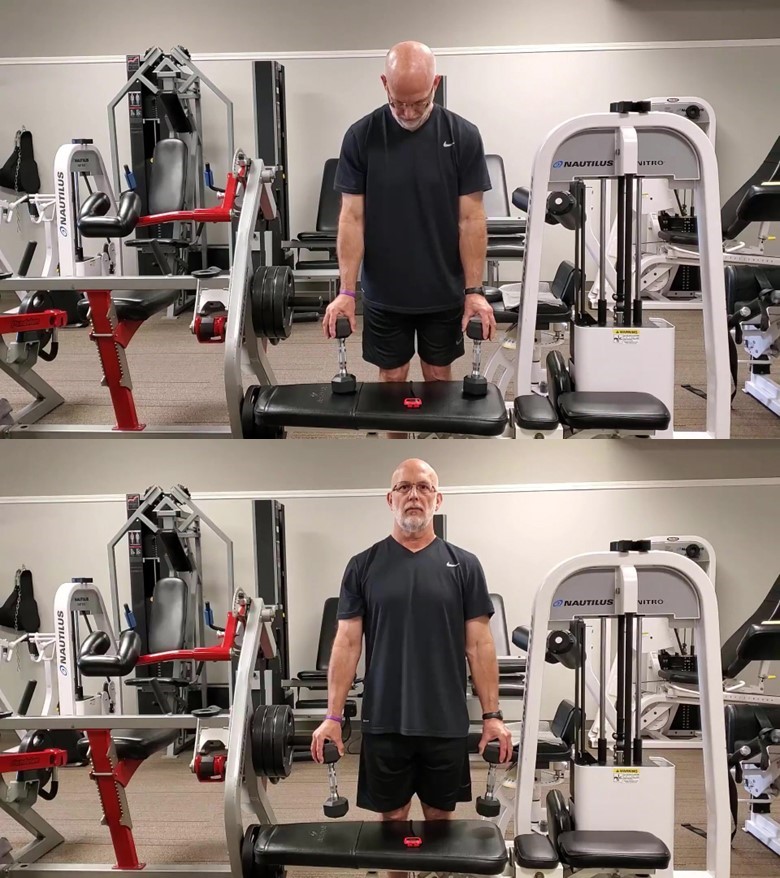 This exercise will strengthen your grip.
This exercise will strengthen your grip.
Place 2 dumbbells on an exercise bench. Standing close to the side of the bench, encircle your fingers and thumb around one end of each dumbbell, positioning the dumbbell vertically.
Start timing yourself as you lift the dumbbells off the bench, standing with your arms by your sides.
Keep gripping the dumbbells as long as you can; when you are about to lose your grip, place the dumbbells back on the bench and stop the timer. Your goal is 45 to 90 seconds.
Why Strength Training Is Important After 50
As you age, maintaining a regular strength training routine becomes increasingly important for overall health and well-being.
After age 50, your muscles naturally begin to lose mass, which can lead to reduced mobility, stability, and endurance. Engaging in strength training exercises can help counteract these effects and keep you strong, healthy, and pain-free.
Strength training primarily focuses on developing your muscles and enhancing your overall muscular strength. By including exercises that target different muscle groups, you can improve your balance and reduce the risk of injuries. Furthermore, strength training can strengthen your joints and increase your range of motion, which will support your body in daily activities and movements.
In addition to building muscle strength, strength training is also essential for maintaining bone density. As you age, your bones may become more susceptible to fractures and breaks, but incorporating strength training exercises can help in preventing this. Also, focusing on neck and posterior shoulder exercises, like shrugs and shoulder “T’s”, will help improve your posture and provide better support for your spine.
One key benefit of strength training is improving flexibility. As you age, staying flexible becomes more important because it can decrease your chances of experiencing strains and injuries. By lowering the weight slowly through a full range of motion, you can ensure that your body has better overall mobility.
Another essential aspect of strength training is enhancing cardiovascular endurance. Although strength training may not have the same immediate cardio benefits as aerobic exercise, it can still contribute to overall heart health and reduce the risk of health problems related to aging, like high blood pressure and heart disease.
FAQ Section – Dumbbell Exercises for Seniors
As seniors embark on their fitness journey with dumbbell exercises, it’s natural to have questions and concerns. Here are some frequently asked questions to provide you with the answers and guidance you need for a safe and effective workout routine.
Is it safe for seniors to use dumbbells for exercise?
Yes, using dumbbells for exercise can be safe and highly beneficial for seniors. However, it’s essential to move the weights slowly and smoothly throughout each exercise to avoid the detrimental effects momentum can have on your joints and connective tissues.
How do I choose the right dumbbell weight?
Take a guess, erring on the side of caution and choosing a weight you think will be kind of light. Start performing reps with proper form, aiming for the suggested rep range (9-12 for legs and midsection, 7-10 for upper body). If you perform 5 or 6 reps and the weight still feels really light, stop and increase the weight a little, and start over. Conversely, if you are forced to stop at 5 or 6 reps, take some weight off and try again.
If you can’t get to the minimum number of the rep range, the weight is too heavy. If you reach the upper level of the rep range easily, the weight is a little light. And if you are forced to stop due to muscular fatigue somewhere between the minimum number and the upper level number of the given rep range, the weight is just right.
What are some precautions to take while exercising with dumbbells?
To exercise safely with dumbbells:
- Maintain proper form and posture during each movement.
- Avoid sudden or jerky motions, and perform the exercises in a controlled manner.
- Make sure you can exit the exercise safely at any time.
Can dumbbell exercises for seniors help with arthritis and joint pain?
Yes, dumbbell exercises can be beneficial for seniors with arthritis and joint pain. Using dumbbells can help improve joint flexibility and muscle strength, easing discomfort.
How often should seniors do dumbbell exercises in a week?
Seniors should aim to engage in dumbbell exercises 2 days a week to start out, with 2 to 3 recovery days in between. For example, Monday-Thursday, Tuesday-Friday, Wednesday-Saturday, etc.
Can dumbbell exercises help improve bone density in seniors?
Yes, dumbbell exercises can contribute to improving bone density in seniors. Weight-bearing exercises, like those performed with dumbbells, can stimulate bone growth and help combat age-related bone loss. However, it’s essential to work with your healthcare professional to design a safe and suitable routine.
Conclusion
- Incorporating dumbbell exercises into the fitness routine of seniors can be a transformative step towards improving their overall well-being and quality of life.
- As we age, staying active becomes even more crucial, and dumbbell training offers a safe, effective, and accessible option for seniors to maintain strength, flexibility, and mobility.
- Regular exercise is essential for seniors as it helps in maintaining muscle mass, bone density, and joint flexibility.
- By utilizing dumbbells, seniors can enhance their upper and lower body strength, improve balance, boost core stability, and increase flexibility and mobility. The exercises described in this article provide seniors with a safe, effective way to target important muscle groups.
- Before embarking on any exercise program, it is wise for seniors to consult with a healthcare professional to ensure their safety and suitability for specific exercises.
- Start with light to moderate weight dumbbells and gradually increase the weight as you become more comfortable and stronger, to prevent injury and promote steady progress.
- Safety tips, such as maintaining proper form and posture during exercises, will minimize the risk of injury.
- Dumbbell exercises are generally safe for seniors, and they can even provide relief from arthritis and joint pain through low-impact movements that improve joint health and reduce inflammation.
In summary, engaging in strength training exercises after 50 will not only prevent the loss of muscle mass but will also support joint health, improve balance, enhance flexibility, and contribute to cardiovascular endurance. By maintaining a consistent routine and focusing on different muscle groups, such as the 5 exercises for seniors discussed here, you can ensure your body stays strong, healthy, and pain-free as you age.

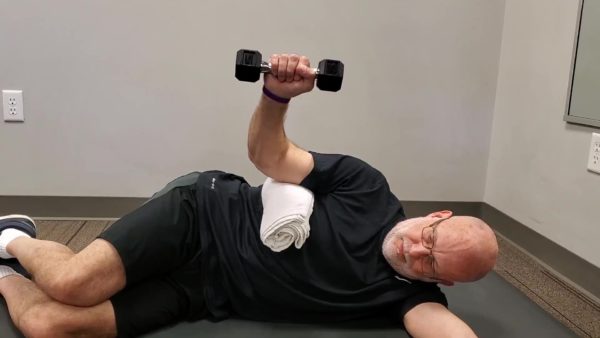
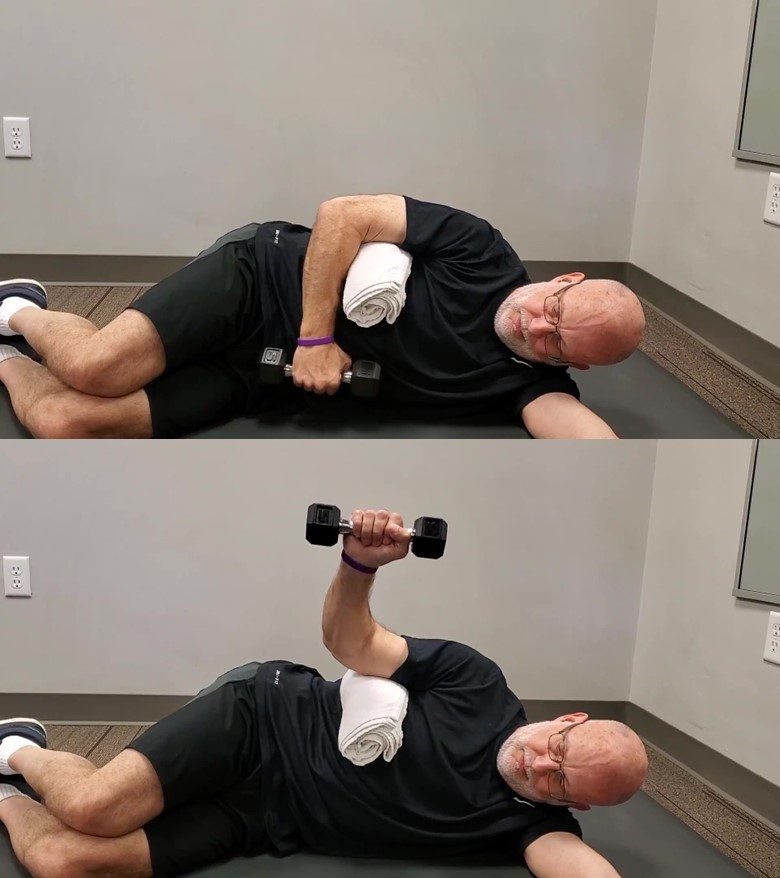
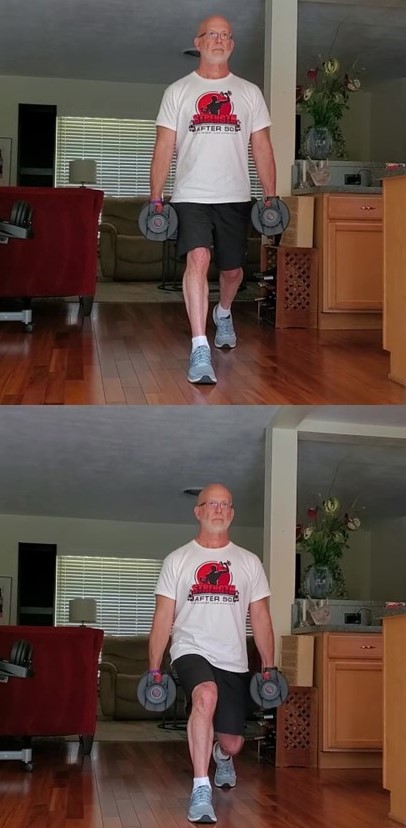
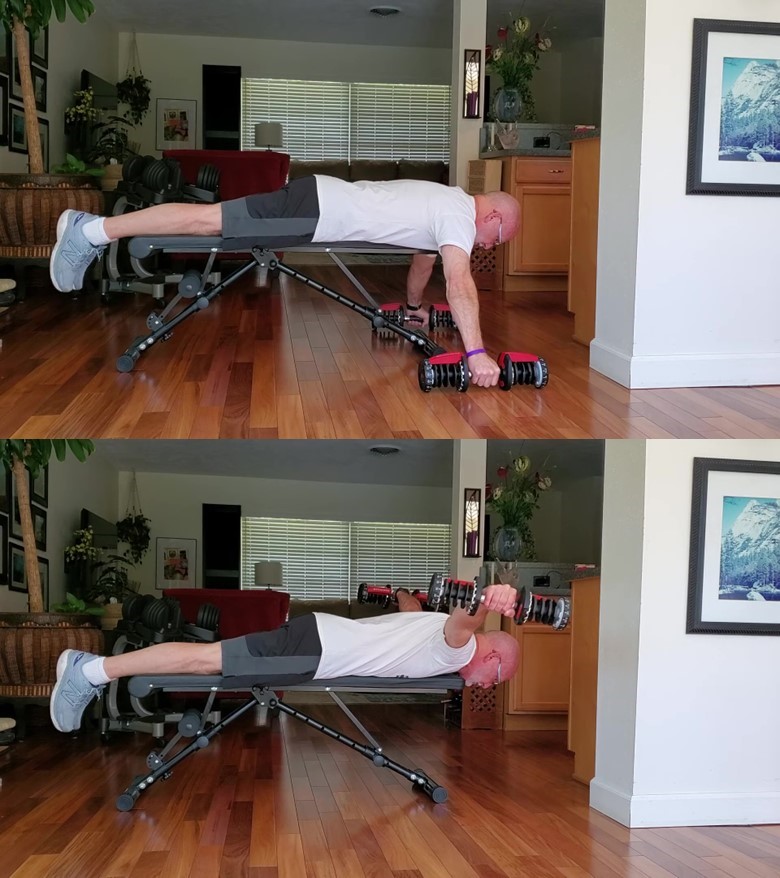

14 Comments. Leave new
Nice article Dave—-thanks for keeping us informed! Question: are you still considering a complete home workout program?
Thanks William, great to hear from you! Hope your training is going well. Yes, home workout program is now available, you can get it here.
Dave,
That is a very good article about the very real use of dumbbells to get stronger and fitter.After 50 we men should not be concerned about 1 RM maxes or just throwing weight around like we did in our younger days. Good common sense and good form are the ways to go. Bury the ego and work for more reps not pounds for a few reps. Thank you for your time and effort! God bless.
Thank you for the kind words Don. I couldn’t agree more, the way we trained in our 20’s is not well suited to the realities we face over 50. We need workout plans that are safe first and foremost, but also effective, time-efficient, and sustainable. And routines that involve 1-rep maxes or throwing weights around do not meet those criteria. Thanks for commenting!
I’ve been getting your emails for a while and I’m sorry to say I haven’t until now I’ll take any opportunity to tell you thank you, although I’ve been weight training for many years I’m learning a lot here and I love that you share this content, necessary content! With all of us Free of charge! Thank you so much Deb
Hi Deb, nice to hear from you, glad to hear someone with your experience is enjoying the site!
Great post Dave!
I know that some novices or those that haven’t been in the weight room in a while can get intimidated by the barbells and large plates. Dumbells are so versatile. I feel they are such a great training tool! I have been incorporating them into my workouts for years. Also use kettlebells which is another versatile piece of equipment.
Thank you again!
Thank you Jay, always great to hear from you! Hope your training is going well!
I appreciate the article. That’s what I am doing—applying some of the principles from your over-50 training program with dumbbells at home. This is helpful.
Hi David, glad you found the article helpful. Dumbbells are great for home training. Using the correct principles of productive strength training makes all the difference, even the best equipment used incorrectly can be ineffective or even dangerous.
Hi Dave. What are your thoughts on resistance bands instead of free weights? Are bands any good? Thank you!
Hi Jim, like free weights, bands provide a source of straight-line resistance, and that resistance can be progressive if you have different color bands, which are different thicknesses, so the thicker ones are harder. Any way you can apply progressive resistance to your muscles will provide the stimulus required for increased strength and muscle size.
There are a couple tricky things with bands you have to be mindful of though – one is you have to be careful with the angles of pull of the band in relation to the strength curve of the muscles you’re working, bands can quickly go from real easy to real hard real quickly if you don’t account for this. Also sometimes it’s more difficult to “Fine tune” progressing the resistance, because one color may be too easy and the next color may be too hard.
I have stopped doing barbell bench press because having my hands in a locked position hurts my shoulders. I now do dumbbell bench press and find being able to turn my wrists to bring my elbows in towards my body a little really saves my shoulder.
Smart move!